As an Amazon Associate, we earn from qualifying purchases with no additional costs for you.
Japan has a long history in the production of steel and manufacturing of superior quality blades. Most genuine Japanese knives are made with Japanese steel, which imparts certain characteristics to the blade. What is all the hype around Japanese steel, and why is it important in knifemaking?
Japanese steels are made using iron ore from a particular region in Japan and mixed with carbon during the smelting process, producing high carbon content, high-quality steel. Japanese steel can be hardened to a higher HRC level allowing a greater degree of sharpness and edge durability.
Mention Japanese steel to anyone, and they immediately think of samurai swords. The reputation of Japanese steel has filtered down through the centuries and to this day persists as high-quality steel for blade manufacturing. What is all the hype around Japanese steel and Japanese knives? Is it justified or simply a marketing ploy?
If you are interested in checking out the best Japanese knives (made by Hayate Yoshihiro) we recommend and use, you can find them by clicking here (Amazon link).

What Steel Is Used In Japanese Knives
The Japanese people are known for their work ethic, attention to detail, and striving for perfection in everything they do. These life philosophies are carried over into the steel produced in Japan, resulting in steel of a higher quality than most other steel-producing countries.
Japan has an advantage, however, in that the iron ore from the Shimane region in Japan is very pure. This high-grade ore, combined with the Japanese attention to detail and desire for perfection, allowed Japan to manufacture top-quality steel when smelting processes were primitive.
Modern techniques have improved on the original Japanese processes, which has kept Japanese steel at the forefront of global top-quality steel production.
The steel from Japan was traditionally called Tamahagane, which roughly translated means “precious jewel steel.”
What Is Tamahagane Steel?
Tamahagane is the name given to Japanese steel produced in the traditional way in clay smelting furnaces.
The main ingredient is the iron ore from the Shimane district in Japan. The ore from this region is called iron sand and comes in two main types: akame satetsu, and masa satetsu.
Typically, masa satetsu is a higher grade ore than akame satetsu, and the two ores are often mixed to produce different quality steel.
This ore is very pure, with low carbon content, so carbon is added to the steel during the smelting process. A bathtub-sized kiln is built from clay, and a fire is built in the kiln, heating it to 1800°F or 1000°C. Charcoal is placed in the kiln, and the satetsu ore is added slowly at the top of the hot coals.
The charcoal imparts carbon to the steel as it melts through the charcoal and deposits itself at the bottom of the clay kiln. The charcoal is constantly turned over with a shovel, and ore is added every 10 minutes over the 36 to 72 hours it takes to produce the steel.
At the end of the process, the clay kiln is broken down to reveal the Tamahagane steel deposited at the bottom of the kiln.
The result is a high carbon content steel with high purity. This steel has allowed the Japanese to produce superior swords and knives since ancient times in their history, making Japanese steel sought after around the world!
Tamahagane is traditional steel, and most modern Japanese steels are not produced this way. Some old-school Japanese craftsmen still produce steel in this way, but commercial knife manufacturers use modern smelting methods.
Mixing various quantities of the two different ore types with other components has allowed a variety of high-quality steel types to be produced in Japan. These steel types impart specific qualities to the blades produced, resulting in the highly valued Japanese knives we know today.
Japanese Knife Steel Chart (Types)
Japanese steel is manufactured to various standards for various applications. The steels are graded according to their type and quality.
Japanese steel is categorized into high carbon steel and stainless steel, with several sub-categories within each of these main types.
We have put together a chart of the different steel types and the differences in quality and purpose.
Japanese High Carbon Steels
| Steel Name | Characteristics | Hardness | Edge Retention |
|---|---|---|---|
| Shirogami #1White Paper SteelWhite Steel | Very hard, but very brittle, requiring special care when using the knife. | 65 HRC and above | ✓✓✓✓ |
| Shirogami #2White Paper SteelWhite Steel | Less brittle than #1 and the most common steel used in kitchen knives – Recommended for first-time Japanese knife owners. | 60 – 63 HRC | ✓✓✓✓✓ |
| Shirogami #3White Paper SteelWhite Steel | Very tough steel, more chip-resistant than #1 and #2, but difficult to sharpen. | 60 HRC | ✓✓ |
| Aogami SuperBlue Paper SteelSuper Blue | High proportions of tungsten, chromium, and carbon. Great but expensive knife making steel. | 65 – 67 HRC | ✓✓✓✓✓ |
| Aogami #1Blue Paper SteelBlue Steel | Aogami #1 can be honed to a very keen edge but is less durable than Blue # 2 | 63 – 65 HRC | ✓✓✓✓ |
| Aogami #2Blue Paper SteelBlue Steel | Edge is more durable than Blue #1 but is not as sharp. | 62 – 65 HRC | ✓✓✓✓✓ |
| Kigami #2Yellow Paper SteelYellow Steel | Less pure version of white steel, with higher levels of phosphorus and sulfur. | 60 – 61 HRC | ✓✓ |
| Kigami #3Yellow Paper SteelYellow Steel | Less carbon content than Kigami #2 | 60 – 61 HRC | ✓✓ |
| SK #3 | Has the highest carbon content of the SK series steel. Good steel for lower-priced knives. | 60 – 61 HRC | ✓✓✓ |
| SK #4 | Mid-grade steel with fewer impurities than SK #5 | 61 – 62 HRC | ✓✓ |
| SK #5 | A low to mid-grade steel with a higher level of impurities and lower carbon content. | 62 – 65 HRC | ✓✓ |
TIP: Japan and Germany are countries renowned for the quality of their craftsmanship and attention to detail in the products they manufacture. Check out the main differences between these two knife types in the article below:
Japanese Vs. German Knives: 9 Differences & Which Is Better
Japanese Stainless Steels
| Steel Name | Characteristics | Hardness | Edge Retention |
|---|---|---|---|
| VG-1 | This is great knife steel, which was a predecessor of VG-10 | 58 – 59 HRC | ✓✓✓✓ |
| VG-10 | One of the most popular Japanese stainless steel for knife making. It holds an edge well and is less expensive than some other stainless steel types. | 60 – 61 HRC | ✓✓✓✓ |
| R2/SG2 | Powdered steel with a consistent grain structure. Easy to sharpen and durable as a knife blade. | 64 HRC | ✓✓✓✓ |
| ZDP189 | This is also powdered steel but requires specialized heat treating, making it very expensive for knife making. | 66 – 67 HRC | ✓✓✓✓✓ |
| AUS8 | Very good entry-level stainless steel for Japanese knives. Rust-resistant and durable. | 58 – 60 HRC | ✓✓✓ |
| AUS10 | Very similar to AUS8, but with better edge retention and much sharper. | 58 – 60 HRC | ✓✓✓✓ |
| SG-2 | Another powdered steel, SG-2 is very popular as an affordable stainless steel with great edge retention. | 64 HRC | ✓✓✓✓ |
| Gingami #3Gin-san | Good steel with sharpness and edge retention comparable to many low to mid-range carbon steels. | 59 – 61 HRC | ✓✓✓ |
| Silver 3 | Considered to be close in cutting performance to the Shirogami steel but with the qualities of stainless steel. | 59 – 61 HRC | ✓✓✓✓ |
The ratings used between these steels are against each other, rather than western steels. Consequently, an SK #3 steel may seem like lower quality steel that you wouldn’t want to make a knife from; it is still great knife steel!
Our choice: Are you interested in buying a stainless or high carbon Japanese knife? Find below our recommendation for these two types of Japanese knives:
Yoshihiro VG-10 Gyuto Japanese Chefs Knife (Amazon link)
Yoshihiro Damascus Steel Santoku Japanese Chefs Knife (Amazon link)
Is Japanese Steel Stainless Steel?
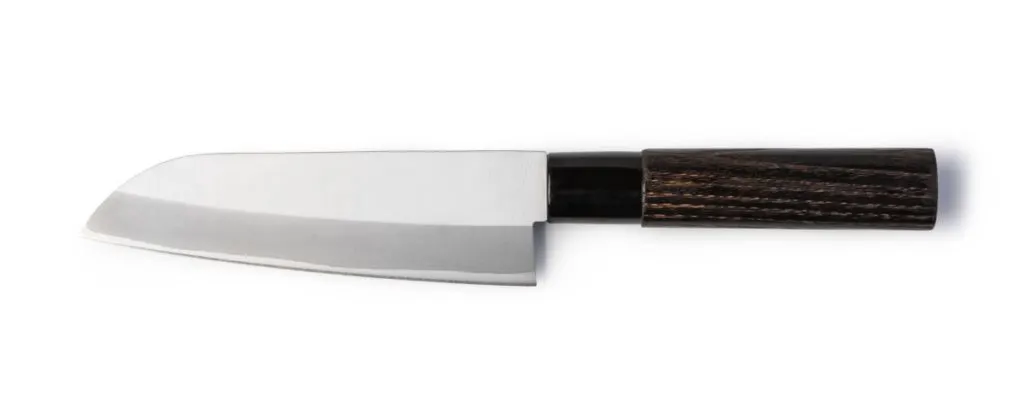
Japanese steel can be high carbon steel or stainless steel. Japan produces high-quality steel in both categories.
The high carbon steel is used as the base to create their stainless steel, transferring the characteristics of the original steel to the stainless steel. This results in high-quality stainless steel that exhibits characteristics closely matched to the high-carbon steel version but with a few differences.
Original Japanese knives were mostly made from carbon steel, but stainless steel was introduced as modern methods were developed. Stainless steel has the same base ingredients as carbon steel but with higher Chromium, Vanadium, and Molybdenum quantities. The Chromium content level in the steel must be a minimum of 13% before it can be classified as stainless.
Japanese stainless steel typically has a higher carbon content than Western stainless steel. This allows the Japanese stainless steel blades to be hardened to a higher HRC level than Western stainless steel.
VG-10 is a popular Japanese stainless steel for knife making because the grain structure of the steel allows it to be sharpened to an edge that is close to the carbon steels and has excellent edge retention.
TIP: Japanese knives are considered to be the ultimate knife to own and use in the kitchen, and they can be really expensive. Find out the main reasons why Japanese knives are worth their price in the article below:
9 Reasons Why Japanese Knives Are Worth Their Price
Is Japanese Steel Good For Knives?
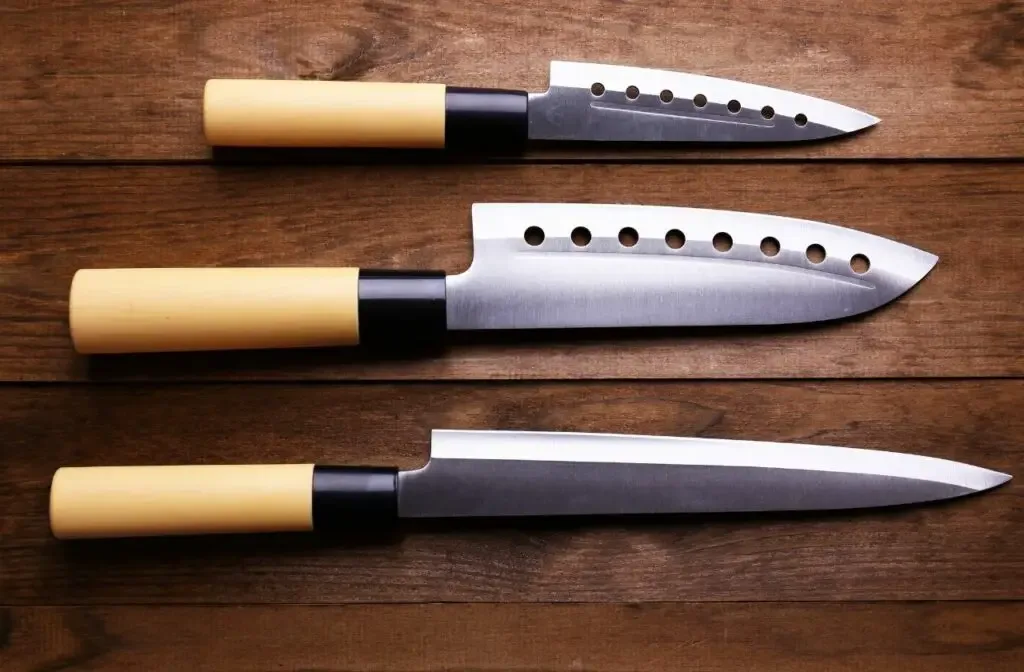
Japanese steel is widely considered some of the best steel for making knives. The high quality of the steel and high carbon content allow the steel to carry a very fine edge and hold the edge for longer than most Western steel.
However, the knife’s purpose should be considered before selecting the steel. A carbon steel blade will be appropriate if you require high-precision cuts.
The composition of Japanese steel lends itself to high hardness, capable of holding a very sharp edge. However, the edges of carbon steel knives are brittle and should be used with care.
Inappropriate use of the knife can result in chipping or cracking of the steel on the knife’s cutting edge. Consequently, Japanese carbon steel blades require more care in their use and maintenance.
Japanese stainless steel creates an edge that is a little more forgiving, and the steel is easier to maintain since it is rust-resistant. However, stainless steel does not hold an edge as well as carbon steel, so it requires more frequent sharpening, and it is more difficult to sharpen due to its greater wear resistance.
TIP: Are you looking to buy a new whetstone? Check out our recommendations (we personally use the first three ones):
Our PRO choice whetstones combo (Amazon links):
- Fixing stone: Whetstone SHAPTON Ceramic KUROMAKU #320
- Sharpening stone: Suehiro CERAX soaking whetstone: Medium #1000
- Finishing stone: Whetstone SHAPTON Ceramic KUROMAKU #5000
Our budget choice (Amazon link): Sharp Pebble Extra Large Sharpening Stone Set
What Is Japanese VG-10 Steel?
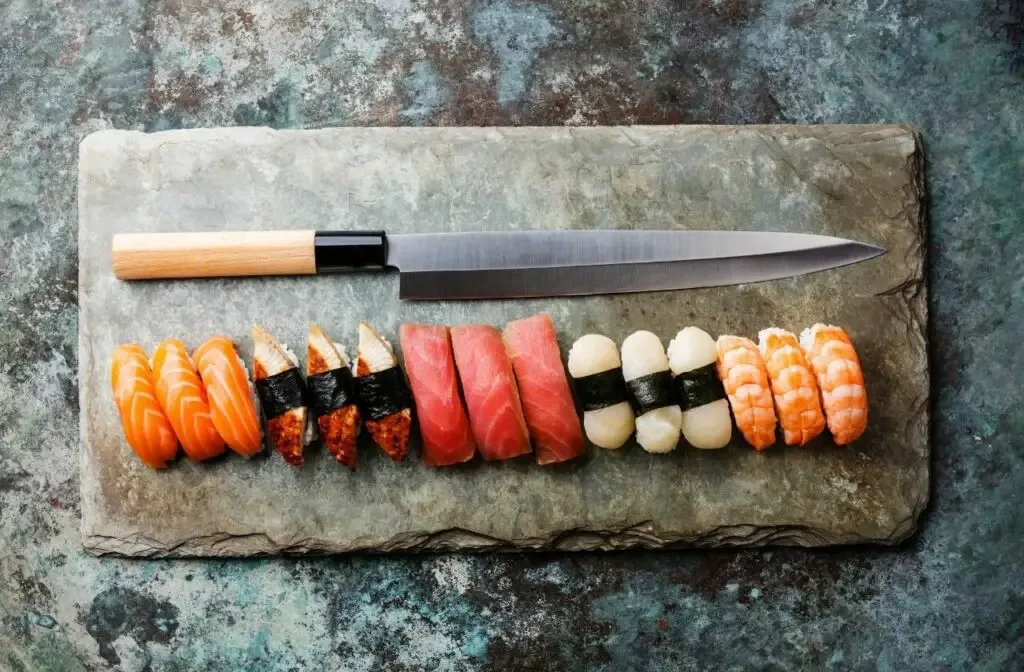
Japanese VG-10 steel is a high-quality stainless steel popular for use in knifemaking. The “G” stands for “gold” and comes from the Japanese naming of this steel as V-kin-10, where “kin” is the Japanese word for gold.
The “gold” designation is intended to portray this steel’s higher refinement and quality over other types.
VG-10 is an improvement on its predecessor, VG-1. The Takefu Special Steel Company produces these stainless steel variants in Japan. The company also produces another variant of VG-10, called VG-10W, which has tungsten added to the steel for greater durability.
VG-10 has 1% carbon, a high carbon content for stainless steel. This higher carbon content gives the steel characteristics similar to carbon steel. Consequently, VG-10 is popular for manufacturing hardworking knives such as bushcraft knives and pocket knives.
Japanese kitchen knives made from VG-10 perform very similarly to carbon steel, making VG-10 popular for making these knives. The stainless steel has the added attraction of requiring less dedication required for the maintenance of the knife.
TIP: Buying genuine Japanese kitchen knives represents a significant investment when it comes to these kitchen tools. Find out the complete guide on how to care for Japanese knives in the article below:
How To Care For Japanese Knives: The Complete Guide
Is Japanese Steel Good Quality?
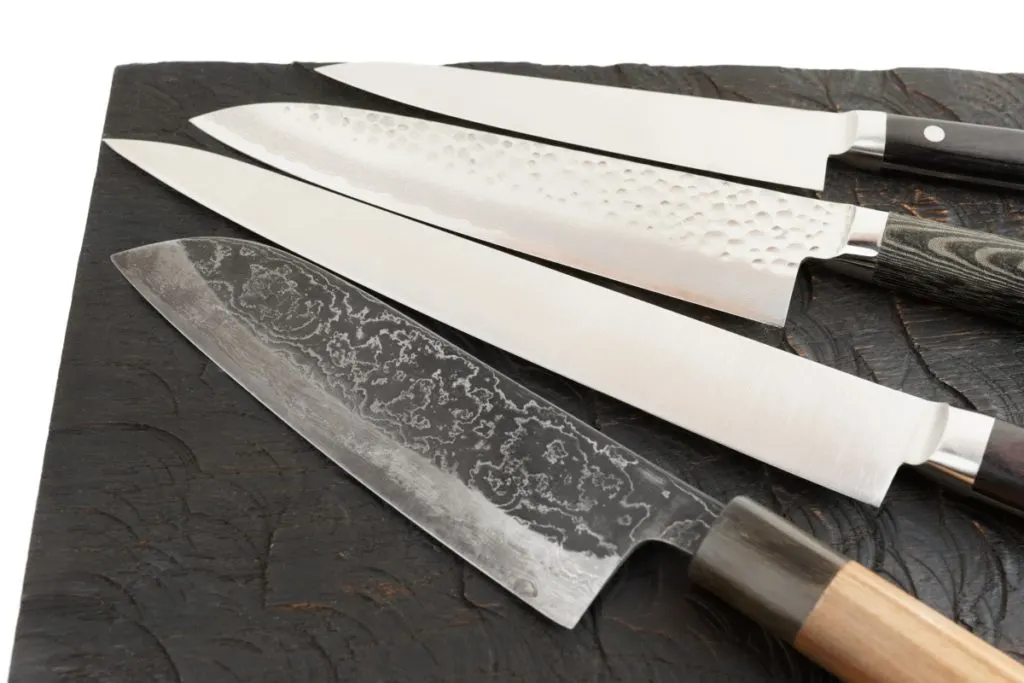
Japan is renowned for its high-quality steel, and as a result, knives made from this steel are in high demand worldwide and often fetch a higher selling price than knives made from other steel.
The quality of Japanese steel is well-known in the market and has resulted in many knock-off Japanese steel knives, often made in China. Chinese steel labeled as Japanese steel such as White steel, or VG-10, is a blatant attempt to capitalize on the good reputation of Japanese steel.
It is not possible for Chinese VG-10 to be the same quality as Japanese steel since the base ore for the steel is only found in Japan. Chinese knives made with Chinese steel are trying to get a higher price for their knives based on the reputation of the Japanese steel.
As a result, you need to do proper research when buying a Japanese knife to ensure you are buying a genuine product rather than paying a lot of money for a knock-off.
When looking for a Japanese knife, it is best to make your purchase from a reputable supplier to ensure the steel is genuinely from Japan.
If you are considering buying your first Japanese kitchen knife, what steel should you look for as the best steel for such a knife?
TIP: The popularity of Japanese knives has resulted in a resurgence of fake knives on the market being passed off as the real deal. Check out how to spot fake Japanese knives in the article below:
Spotting FAKE Japanese Knives: 8 Features To Watch Out For
Best Steel For Japanese Knives
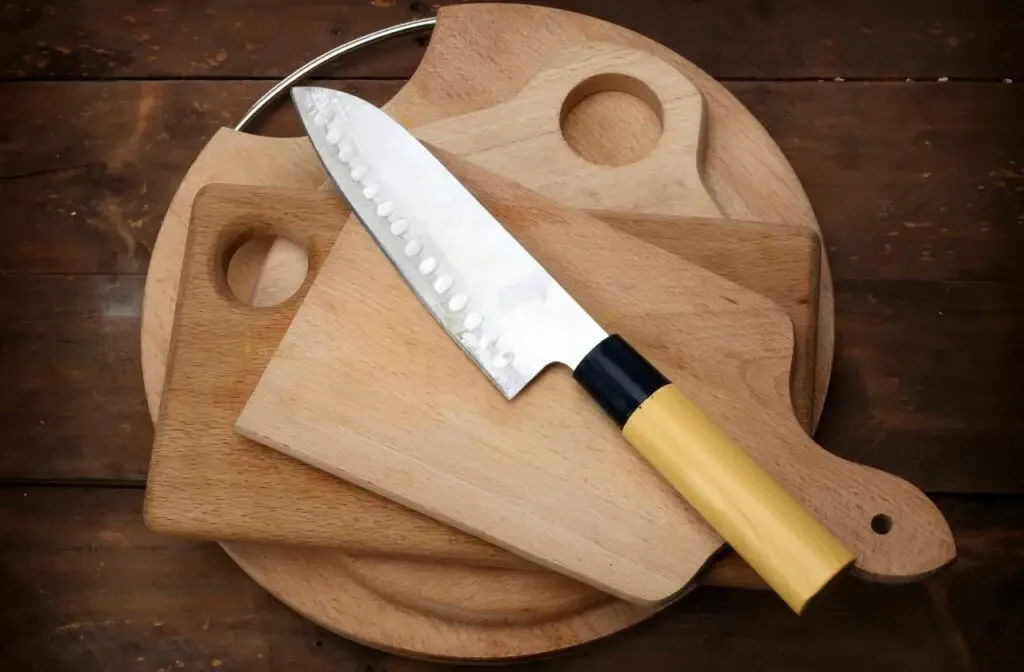
Japanese knives are not cheap, and the higher the quality of the steel, the more expensive the knife will be.
Super Blue Steel is the best steel for a Japanese knife, but the price tag on a knife made from this steel would place the knife beyond the budget for most of us!
Super Blue is considered a steel reserved for high-end knives for professional chefs who know how to use and take care of these knives.
We would recommend a knife made from Shirogami #2 steel from a carbon steel perspective. The steel is relatively pure, with a very fine grain. The fine grain allows for a very sharp edge, and sharpening is not difficult. Knives made from this steel are also reasonably priced, keeping them within reach of most people.
A knife made from SK #3 is a great option for a more budget-friendly option in the carbon steel category. SK #3 is good steel suitable for most home-kitchen style knife use and would be a great choice as a first-time Japanese knife at a very reasonable price.
If you prefer the convenience of stainless steel, we recommend looking for a knife made from VG-10 or a slightly more budget-friendly option, AUS10. The VG-10 option can be a little pricey due to the demand for this steel, but you will not regret parting with a little extra cash to purchase a VG-10 knife.
AUS10 is a good alternative that is generally a little cheaper but exhibits good wear resistance, sharpness, and edge retention.
Take into account the frequency of use for your Japanese knife and the cost of the high-end knives. Should your knife use warrant a more expensive option, go ahead and treat yourself. However, for modest use, a more modest knife would be a more appropriate and better use of your money. You will still be blown away by the experience of using your Japanese knife compared to other knives.
BTW: If you want to know more about Japanese and other knives and their sharpening, check out the books listed above. These books are recommended by professional sharpeners and knife makers (Amazon links):
- Japanese Kitchen Knives: Essential Techniques and Recipes
- The Knifenerd Guide to Japanese Knives
- Knife: The Culture, Craft, and Cult of the Cook’s Knife
- Sharp: The Definitive Introduction to Knives, Sharpening, and Cutting Techniques, with Recipes from Great Chefs
Frequently Asked Questions About Japanese Knife Steel
Q: What makes Japanese steel unique for knife-making?
A: Japanese steel is renowned for its high carbon content, allowing it to be hardened to a higher HRC level. This results in a blade that can achieve a greater level of sharpness and edge durability. The meticulous smelting process and the purity of the raw iron from the Shimane region in Japan contribute to its uniqueness.
Q: Why are Japanese knives so sharp?
A: The high carbon content in Japanese steel allows it to be sharpened to an especially fine edge. Additionally, traditional Japanese sharpening techniques contribute to achieving and maintaining this sharpness.
Q: What is Tamahagane steel?
A: Tamahagane is a traditional Japanese steel produced in clay smelting furnaces. It is made primarily from the iron ore of the Shimane district in Japan, known for its purity. The steel is characterized by its particularly high carbon content and purity, making it sought after for blade crafting.
Q: Are all Japanese knives made from carbon steel?
A: No, while many traditional Japanese knives are made from carbon steel, there are also Japanese knives made from stainless steel. Stainless steel versions are often preferred for their rust-resistant properties.
Q: How do Japanese carbon steel and stainless steel knives differ?
A: Japanese carbon steel knives can achieve a sharper edge and often have better edge retention than stainless steel knives. However, they are more prone to rust and require more care. Stainless steel knives are rust-resistant and may be more durable but might not achieve the same sharpness level as carbon steel knives.
Q: What is VG-10 steel?
A: VG-10 is a high-quality stainless steel popular in knife-making. Produced by the Takefu Special Steel Company in Japan, VG-10 is known for its high carbon content, allowing it to exhibit characteristics similar to carbon steel, making it a favorite for hardworking knives.
Q: How do I care for my Japanese knife?
A: Japanese knives, especially those made from carbon steel, require careful maintenance. It’s essential to keep them dry to prevent rusting, sharpen them using appropriate techniques, and store them properly. Regularly cleaning and occasionally oiling the blade can also help prolong its life.
Q: Are Japanese knives suitable for beginners?
A: Yes, but it’s essential to choose the right type. For beginners, a knife made from Shirogami #2 or a stainless steel variant like VG-10 or AUS10 might be more suitable due to their balance of sharpness, durability, and maintenance ease.
Q: Why are Japanese knives more expensive than other knives?
A: The meticulous crafting process, the quality of the steel, and the traditional techniques employed in making Japanese knives contribute to their higher cost. The reputation of Japanese steel and the unparalleled performance of these knives also play a role in their premium pricing.
Q: How can I ensure I’m buying a genuine Japanese knife and not a knock-off?
A: It’s crucial to purchase from reputable suppliers or directly from known Japanese knife brands. Researching the brand, checking for certifications, and reading reviews can also help ensure the authenticity of the knife.
Conclusion
Japanese steel is some of the best knife-making steel in the world, and its reputation for sharpness and edge retention has given knives made from these steels a reputation above all others.
Japanese knives are prestigious to own but require more care regarding maintenance and use than most other knives. However, the experience of using one of these knives justifies the reputation and the expense of owning a knife made from Japanese steel!
TIP: Choosing your first Japanese knife can raise a few questions about which style of knife to choose. Check out the ultimate guide on choosing your first Japanese knife in the article below:
Choosing Your First Japanese Knife (Ultimate Guide + Tips)
